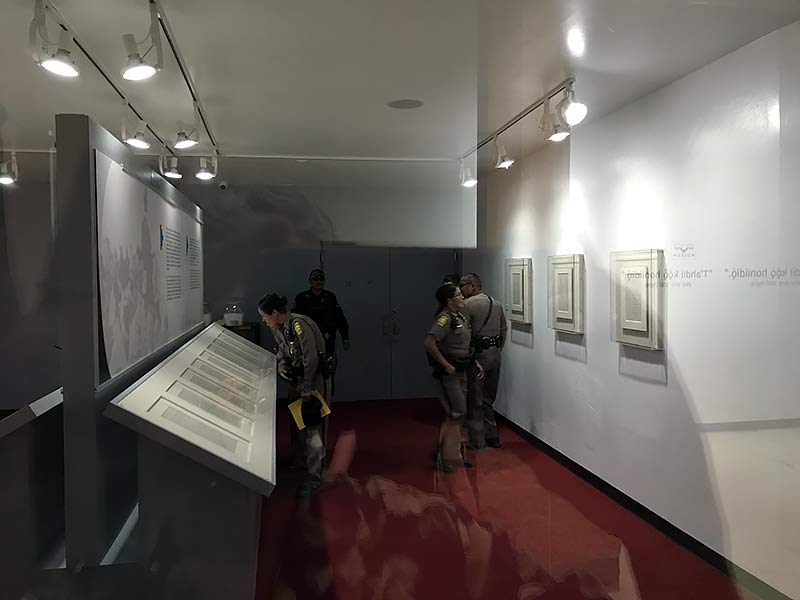
Treaty of 1868 is here!

Navajo Times / Cindy Yurth Navajo Nation Police recruits view the Treaty of 1868 at the Navajo Nation Museum.
WINDOW ROCK
The treaty that helped the imprisoned Navajo people return to their homeland is here and goes on display today (June 1) at the Navajo Nation Museum.
June 1st marks the 150th year since the Treaty of 1868 was signed by Barboncito, Manuelito, Ganado Mucho, Delgadito, and 25 other Diné headmen at Ft. Sumner, New Mexico.
It was ratified on July 25, 1868, and proclaimed by President Andrew Johnson in August of that same year.
Bringing the delicate document to the Navajo Nation for the first time took more than a year to meet the strict requirements of the National Archives and Records Administration, where the treaty is kept.
Museum Director Manuelito Wheeler said he and his staff have worked long hours since April, preparing the museum for the treaty, which arrived on Tuesday evening.
“People are coming to have the experience of being with the actual treaty,” he said. “Most of the them have been waiting for this. They’ve only heard about it, read about it, but they’ve never seen it or been with it.
“People are coming to see our leaders’ actual marks,” he said. “They want to see Barboncito’s actual mark. That is gonna be a very powerful experience. I think regardless of our different faiths, I think people are gonna be touched by it.”
The treaty, which is encased in layers of glass in a room that must maintain a humidity level between 35 and 50 percent, will not be photographed, Wheeler said.
Security officers will be standing by the 150-year-old document and the “dos and don’ts” rules will be displayed on a wall. In addition, security will be checking bags.
But people coming to see the treaty may take as long as they wish with it, he said.
However, he said opening day would probably not be the best time since he was anticipating droves of people lined up. He recommended any other time in June.
The museum will open its doors Friday at 9 a.m. with special guest speakers. A public forum will also be held inside the auditorium as well as activities for children.
The exhibit will be open the entire month of June, between 9 a.m. and 6 p.m.
While the U.S. government’s copy of the treaty has never been on Navajo Nation soil, it is not the first time it has come to Arizona. In 1998, NAU hosted the treaty for a year in Flagstaff.
Evangeline Parsons-Yazzie, a professor of Navajo in the Department of Modern Languages, said in a 1998 Arizona Republic interview the treaty would encourage the “elders to begin the discussion and the teachings again.”
The display of the treaty at the time, which was endorsed by the 18th Navajo Nation Council, did not come with controversy. Traditionalists were against the display and said the treaty was not supposed to ever touch Navajo soil and asked the university to have a ceremony done. Joe Kee, a professor at NAU, headed the request, which was later granted.
This time around, Wheeler said, constant discussions as to what should be done and can be done were held, and at least two ceremonies have already been conducted on behalf of treaty coming to the Navajo Nation.
In fact, he said a hóchxǫ’íjí ceremony was performed as soon as it arrived at the museum.
“We listened to the request of the hataałiis and got that done right away,” he said, noting the ceremony was to cleanse the treaty.
Wheeler said the most powerful information will come from the people themselves.
“We just want to open up the mic for the Navajo people,” he said. “We want our people to come and tell their stories about the Long Walk. To me, that’s the most powerful information we have is our stories.”
The second known copy of the treaty, which is in the possession of a great-grandniece of signer Samuel Tappan, will be displayed Saturday, June 9, at the Fort Sumner Historic Site/Bosque Redondo Memorial, accompanied by speakers and cultural dances.
Following the ceremonies, participants are invited to participate in a seven-mile walk from the memorial to Fort Sumner High School in honor of the Navajos who returned to their homeland after the treaty was signed.
For those who don’t believe the treaty should be visited or celebrated, there will be an observance today (June 1) at the Shiprock Chapter House starting at 10 a.m.
“There will be stories of our time as prisoners of war at Hweeldi, we will consider the treaty as a document in today’s circumstances. Finally we will consider a Declaration of Diné Identity,” wrote Shiprock Chapter President Duane “Chili” Yazzie in describing the event.
“The purpose will be to have the people understand the proposed declaration, ask the attendees to approve the document and have whoever wants to sign the declaration sign,” he said.
To read the full article, pick up your copy of the Navajo Times at your nearest newsstand Thursday mornings!
Are you a digital subscriber? Read the most recent three weeks of stories by logging in to your online account.








 Highway 264,
Highway 264, I-40, WB @ Winslow
I-40, WB @ Winslow